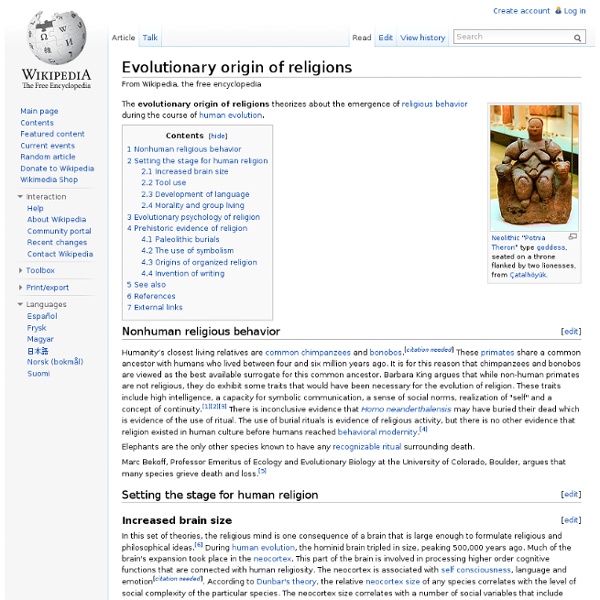Secular humanism
The philosophy or life stance of secular humanism (alternatively known by some adherents as Humanism, specifically with a capital H to distinguish it from other forms of humanism) embraces human reason, ethics, and philosophical naturalism while specifically rejecting religious dogma, supernaturalism, pseudoscience, and superstition as the basis of morality and decision making.[1][2][3][4] The International Humanist and Ethical Union (IHEU) is the world union of more than one hundred Humanist, rationalist, irreligious, atheistic, Bright, secular, Ethical Culture, and freethought organizations in more than 40 countries. The "Happy Human" is the official symbol of the IHEU as well as being regarded as a universally recognised symbol for those who call themselves Humanists. Secular humanist organizations are found in all parts of the world. Those who call themselves humanists are estimated to number between four and five million people worldwide. Terminology[edit] History[edit] Case law[edit]
Humanism
In modern times, humanist movements are typically aligned with secularism, and today "Humanism" typically refers to a non-theistic life stance centred on human agency, and looking to science instead of religious dogma in order to understand the world.[2] Background The word "Humanism" is ultimately derived from the Latin concept humanitas, and, like most other words ending in -ism, entered English in the nineteenth century. However, historians agree that the concept predates the label invented to describe it, encompassing the various meanings ascribed to humanitas, which included both benevolence toward one's fellow humans and the values imparted by bonae litterae or humane learning (literally "good letters"). In the second century A.D, a Latin grammarian, Aulus Gellius (c. 125– c. 180), complained: Gellius says that in his day humanitas is commonly used as a synonym for philanthropy – or kindness and benevolence toward one's fellow human being. History Predecessors Asia Ancient Greece Types
Freethought
For the Ukrainian language newspaper published in Australia, see The Free Thought. Freethought or free thought is a philosophical viewpoint which holds that positions regarding truth should be formed on the basis of logic, reason, and empiricism, rather than authority, tradition, or other dogmas.[1][2][3] The cognitive application of freethought is known as "freethinking", and practitioners of freethought are known as "freethinkers".[1][4] Freethought holds that individuals should not accept ideas proposed as truth without recourse to knowledge and reason. Thus, freethinkers strive to build their opinions on the basis of facts, scientific inquiry, and logical principles, independent of any logical fallacies or the intellectually limiting effects of authority, confirmation bias, cognitive bias, conventional wisdom, popular culture, prejudice, sectarianism, tradition, urban legend, and all other dogmas. Symbol[edit] The pansy, symbol of freethought History[edit] Pre-modern movement[edit]
Secular Coalition for America
Logo of the Secular Coalition for America The Secular Coalition works to increase visibility and respect for nontheistic viewpoints in the United States and to protect and strengthen the secular character of the U.S. government. The Coalition advocates complete separation of church and state within American politics which they claim is clearly established in the U.S. Constitution under the First Amendment. They point out that freedom of conscience, which includes religious freedom, was of such importance that it was made the first of all freedoms protected in the Bill of Rights.[2] The Coalition holds reason and science as its guiding tenets for public policy. Mission[edit] The mission of the Secular Coalition for America is to increase the visibility, amplify the diversity of, and respect for, the growing voice of the nontheistic community in the United States, and to protect and strengthen the secular character of government as the best guarantee of freedom for all. History[edit]
Maslow's hierarchy of needs
Maslow's hierarchy of needs, represented as a pyramid with the more basic needs at the bottom[1] Maslow's hierarchy of needs is a theory in psychology proposed by Abraham Maslow in his 1943 paper "A Theory of Human Motivation" in Psychological Review.[2] Maslow subsequently extended the idea to include his observations of humans' innate curiosity. His theories parallel many other theories of human developmental psychology, some of which focus on describing the stages of growth in humans. Maslow used the terms "physiological", "safety", "belongingness" and "love", "esteem", "self-actualization", and "self-transcendence" to describe the pattern that human motivations generally move through. Maslow's theory was fully expressed in his 1954 book Motivation and Personality.[5] The hierarchy remains a very popular framework in sociology research, management training[6] and secondary and higher psychology instruction. Hierarchy Physiological needs Safety needs Safety and Security needs include:



